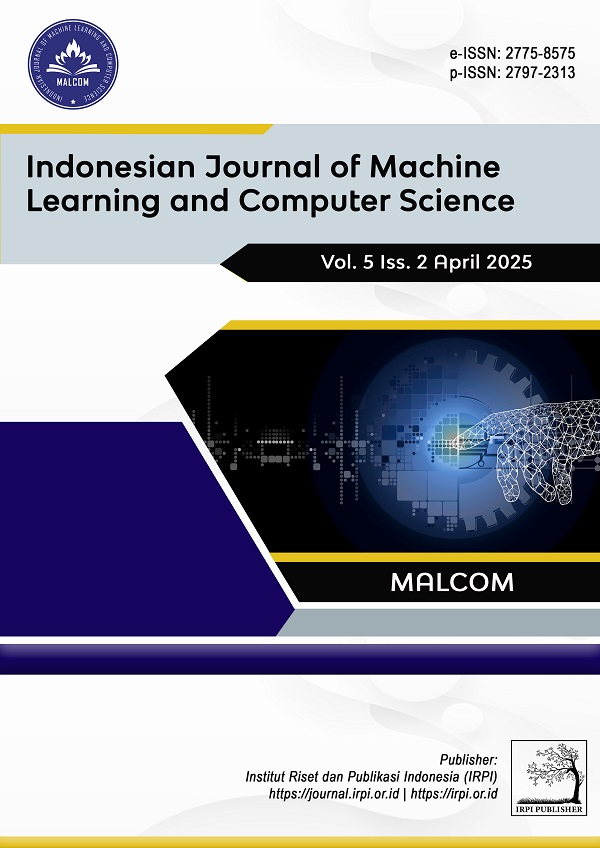Penerapan Algoritma Naive Bayes dengan Teknik TF-IDF dan Cross Validation untuk Analisis Sentimen Terhadap Starlink
Application of the Naive Bayes Algorithm with TF-IDF and Cross Validation Techniques for Sentiment Analysis Towards Starlink
DOI:
https://doi.org/10.57152/malcom.v5i2.1852Keywords:
Analisis Sentimen, Cross Validation, Naïve Bayes, Starlink, TF-IDFAbstract
Starlink, layanan internet satelit dari SpaceX, mulai beroperasidi Indonesia pada 2024 untuk mengatasi kesenjangan digital di wilayah terpencil. Namun, kehadirannya menimbulkan tantangan seperti harga tinggi, potensi dampak terhadap penyedia lokal, dan masalah regulasi. Penelitian ini mengkaji sentimen publik terhadap Starlink menggunakan algoritma Naïve Bayes yang dikombinasikan dengan teknik TF-IDF dan Cross Validation yang masih jarang diterapkan dalam studi serupa di Indonesia. Data yang digunakan berupa cuitan berbahasa Indonesia dari pengguna platform X selama Mei-November 2024. Hasil analisis menunjukkan bahwa model Naïve Bayes memiliki kinerja optimal dalam mendeteksi sentimen positif dibandingkan negatif maupun netral, sebagaimana diukur menggunakan confusion matrix. Temuan utama menunjukkan bahwa Naïve Bayes 49,38% cuitan bersentimen positif, 32,94% netral, dan 17,68% negatif. Sentimen positif didominasi oleh apresiasi terhadap kecepatan dan stabilitas layanan, sedangkan sentimen negatif mengkritik harga tinggi dan dampaknya terhadap penyedia lokal. Meskipun model menunjukkan performa baik pada sentimen positif, akurasi klasifikasi sentimen negatif dan netral masih perlu ditingkatkan. Hasil penelitian ini memberikan wawasan strategis bagi pengembangan bisnis Starlink serta dasar pertimbangan bagi pemerintah terkait layanan internet berbasis satelit di Indonesia.
Downloads
References
W. Rakhmawati, C. E. Kosasih, R. Widiasih, S. Suryani, and H. Arifin, “Internet Addiction Among Male Adolescents in Indonesia: A Qualitative Study,” Am. J. Mens. Health, vol. 15, no. 3, 2021, doi: 10.1177/15579883211029459.
J. Caron and J. R. Markusen, “Importancy Of Internet,” vol. 2, no. 13, pp. 1–23, 2016.
APJII, “APJII Jumlah Pengguna Internet Indonesia Tembus 221 Juta Orang,” APJII. Accessed: Aug. 07, 2024. [Online]. Available: https://apjii.or.id/berita/d/apjii-jumlah-pengguna-internet-indonesia-tembus-221-juta-orang
R. Dewantara, P. A. Cakranegara, A. J. Wahidin, A. Muditomo, I. Gede, and I. Sudipa, “Implementasi Metode Preference Selection Index Dalam Penentuan Jaringan Dan Pemanfaatan Internet Pada Provinsi Indonesia,” J. Sains Komput. Inform. (J-SAKTI, vol. 6, no. 2, pp. 1226–1238, 2022.
ASSI, “Starlink Masuk Indonesia, Pengusaha Lokal Mulai Tingkatkan Kapasitas Satelit,” ASSI. [Online]. Available: https://apsat.assi.or.id/2024/06/07/starlink-masuk-indonesia-pengusaha-lokal-mulai-tingkatkan-kapasitas-satelit/#:~:text=Sebelumnya Elon Musk meresmikan peluncuran,19%2F05%2F2024).
T. Duan and V. Dinavahi, “Starlink Space Network-Enhanced Cyber–Physical Power System,” IEEE Trans. Smart Grid, vol. 12, no. 4, pp. 3673–3675, 2021, doi: 10.1109/TSG.2021.3068046.
M. S. Kalaivani, S. Jayalakshmi, and R. Priya, “Comparative analysis of sentiment classification using machine learning techniques on Twitter data,” Int. J. Health Sci. (Qassim)., vol. 6, no. April, pp. 8273–8280, 2022, doi: 10.53730/ijhs.v6ns2.7098.
M. A. Saddam, E. K. Dewantara, and A. Solichin, “Sentiment Analysis of Flood Disaster Management in Jakarta on Twitter Using Support Vector Machines,” Sinkron, vol. 8, no. 1, pp. 470–479, 2023, doi: 10.33395/sinkron.v8i1.12063.
B. Liu, Sentiment analysis: Mining opinions, sentiments, and emotions. 2015. doi: 10.1017/CBO9781139084789.
M. Wankhade, A. C. S. Rao, and C. Kulkarni, A survey on sentiment analysis methods, applications, and challenges, vol. 55, no. 7. Springer Netherlands, 2022. doi: 10.1007/s10462-022-10144-1.
wesam ahmed, N. Semary, K. Amin, and M. Adel Hammad, “Sentiment Analysis on Twitter Using Machine Learning Techniques and TF-IDF Feature Extraction: A Comparative Study,” IJCI. Int. J. Comput. Inf., vol. 10, no. 3, pp. 52–57, 2023, doi: 10.21608/ijci.2023.236052.1128.
R. O. M. Khalil Gibran1, Mhd Ikhsan Rifki2, Abdul Halim Hasugian3,Ahmad Taufik Al Afkari Siahaan4, Afandi Sahputra5, “Sentiment Analysis of Platform X Users on Starlink Using Naive Bayes,” Instal J. Komput., vol. 10, no. July, 2024, [Online]. Available: https://journalinstal.cattleyadf.org/index.php/Instal/article/view/240
S. Sardin, A. Nugroho, and N. T. Kurniadi, “Sentiment Analysis of Starlink on Twitter Using Support Vector Machine Algorithm,” J. Comput. Networks, Archit. High Perform. Comput., vol. 6, no. 3, pp. 1321–1332, 2024, doi: 10.47709/cnahpc.v6i3.4348.
N. Nicholas and R. Sutomo, “Comparative Analysis of Sentiment Analysis Using the Support Vector Machine and Naive Bayes Algorithm on Cryptocurrencies,” J. Multidiscip. Issues, vol. 1, no. 3, pp. 2–19, 2021, doi: 10.53748/jmis.v1i3.22.
S. M. Permataning Tyas, B. S. Rintyarna, and W. Suharso, “The Impact of Feature Extraction to Naïve Bayes Based Sentiment Analysis on Review Dataset of Indihome Services,” Digit. Zo. J. Teknol. Inf. dan Komun., vol. 13, no. 1, pp. 1–10, 2022, doi: 10.31849/digitalzone.v13i1.9158.
A. Rahmatulloh, R. N. Shofa, I. Darmawan, and Ardiansah, “Sentiment Analysis of Ojek Online User Satisfaction Based on the Naïve Bayes and Net Brand Reputation Method,” in 2021 9th International Conference on Information and Communication Technology (ICoICT), 2021, pp. 337–341. doi: 10.1109/ICoICT52021.2021.9527466.
A. Addiga and S. Bagui, “Sentiment Analysis on Twitter Data Using Term Frequency-Inverse Document Frequency,” J. Comput. Commun., vol. 10, no. 08, pp. 117–128, 2022, doi: 10.4236/jcc.2022.108008.
Y. Zhang, Y. Zhou, and J. T. Yao, Feature Extraction with TF-IDF and Game-Theoretic Shadowed Sets, vol. 1237 CCIS. Springer International Publishing, 2020. doi: 10.1007/978-3-030-50146-4_53.
Lisnawati, “Kehadiran Starlink di Indonesia?: Manfaat dan Dampak,” Info Singk. Kaji. Singk. Tehadap isu Aktual dan Strateg., vol. 16, no. 11, pp. 16–20, 2024.
BBC, “Pro-kontra Starlink di Indonesia - ‘Pemain lokal juga mampu, pemerintah jangan anak emaskan pemain asing,’” BBC. [Online]. Available: https://www.bbc.com/indonesia/articles/cmll91z484ro
H. R. Alhakiem and E. B. Setiawan, “Aspect-Bas1ed Sentiment Analysis on Twitter Using Logistic Regression with FastText Feature Expansion,” J. RESTI (Rekayasa Sist. dan Teknol. Informasi), 2022, [Online]. Available: https://api.semanticscholar.org/CorpusID:253335745
I. S. Thalib, S. K. Gusti, F. Yanto, and M. Affandes, “Klasifikasi Sentimen Tragedi Kanjuruhan Pada Twitter Menggunakan Algoritma Naïve Bayes,” J. Sist. Komput. dan Inform., vol. 4, no. 3, p. 467, 2023, doi: 10.30865/json.v4i3.5852.
E. Puspita, D. F. Shiddieq, and F. F. Roji, “Pemodelan Topik pada Media Berita Online Menggunakan Latent Dirichlet Allocation (Studi Kasus Merek Somethinc),” MALCOM Indones. J. Mach. Learn. Comput. Sci., vol. 4, no. 2, pp. 481–489, 2024, doi: 10.57152/malcom.v4i2.1204.
I. Verawati and S. N. Jaelani, “JURNAL MEDIA INFORMATIKA BUDIDARMA Analisis Sentimen Pengguna Twitter Terhadap Bus Listrik Menggunakan Naïve Bayes,” J. Media Inform. Budidarma, vol. 8, no. 2, pp. 832–842, 2024, doi: 10.30865/mib.v8i2.7030.
L. Xiang, “Application of an Improved TF-IDF Method in Literary Text Classification,” Adv. Multimed., vol. 2022, 2022, doi: 10.1155/2022/9285324.
R. Kosasih and A. Alberto, “Sentiment analysis of game product on shopee using the TF-IDF method and naive bayes classifier,” Ilk. J. Ilm., vol. 13, no. 2, pp. 101–109, 2021, doi: 10.33096/ilkom.v13i2.721.101-109.
Y. D. Kirana and S. Al Faraby, “Sentiment analysis of beauty product reviews using the K-nearest neighbor (KNN) and TF-IDF methods with chi-square feature selection,” 2021, scholar.archive.org. [Online]. Available: https://scholar.archive.org/work/ye6ofgjo45ey5fahm5jmjr55za/access/wayback/https://commdis.telkomuniversity.ac.id/jdsa/index.php/jdsa/article/download/71/31/
T. N. Viet et al., “The Naïve Bayes Algorithm,” vol. 12, no. 4, pp. 1038–1043.
G. I. Webb, “Notsonaive,” Not So Naive Bayes Aggregating One-Dependence Estim., vol. 58, no. 5–24, pp. 5–24, 2005, [Online]. Available: papers://5e3e5e59-48a2-47c1-b6b1-a778137d3ec1/Paper/p1997
T. Ridwansyah, “Implementasi Text Mining Terhadap Analisis Sentimen Masyarakat Dunia Di Twitter Terhadap Kota Medan Menggunakan K-Fold Cross Validation Dan Naïve Bayes Classifier,” KLIK Kaji. Ilm. Inform. dan Komput., vol. 2, no. 5, pp. 178–185, 2022, doi: 10.30865/klik.v2i5.362.
A. Seraj et al., “Chapter 5 - Cross-validation,” S. Eslamian and F. B. T.-H. of H. Eslamian, Eds., Elsevier, 2023, pp. 89–105. doi: https://doi.org/10.1016/B978-0-12-821285-1.00021-X.
R. S. Kharisma, Muttafi’ah, and A. Dahlan, “Comparison of Naïve Bayes Algorithm Model Combinations with Term Weighting Techniques in Sentiment Analysis,” in 2021 4th International Conference on Information and Communications Technology (ICOIACT), 2021, pp. 160–163. doi: 10.1109/ICOIACT53268.2021.9563999.
H. Kaur and N. K. Sandhu, “International Journal of Communication Networks and Information Security Evaluating the Effectiveness of the Proposed System Using F1 Score , Recall , Accuracy , Precision and Loss Metrics Compared to Prior Techniques,” vol. 15, no. 04, pp. 368–383, 2023.
Downloads
Published
How to Cite
Issue
Section
License
Copyright (c) 2025 MALCOM: Indonesian Journal of Machine Learning and Computer Science

This work is licensed under a Creative Commons Attribution-ShareAlike 4.0 International License.
Copyright © by Author; Published by Institut Riset dan Publikasi Indonesia (IRPI)
This Indonesian Journal of Machine Learning and Computer Science is licensed under a Creative Commons Attribution-ShareAlike 4.0 International License.




















